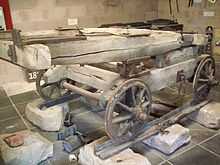Bicslade Tramroad
| Bicslade Tramroad | |||||||||||||||||||||||||||||||||||||||||||||||||||||||||||||||||||||||||||||||||||||||||||||||||||||||||||||||||||||||||||||||||||||||||
|---|---|---|---|---|---|---|---|---|---|---|---|---|---|---|---|---|---|---|---|---|---|---|---|---|---|---|---|---|---|---|---|---|---|---|---|---|---|---|---|---|---|---|---|---|---|---|---|---|---|---|---|---|---|---|---|---|---|---|---|---|---|---|---|---|---|---|---|---|---|---|---|---|---|---|---|---|---|---|---|---|---|---|---|---|---|---|---|---|---|---|---|---|---|---|---|---|---|---|---|---|---|---|---|---|---|---|---|---|---|---|---|---|---|---|---|---|---|---|---|---|---|---|---|---|---|---|---|---|---|---|---|---|---|---|---|---|---|
Legend
| |||||||||||||||||||||||||||||||||||||||||||||||||||||||||||||||||||||||||||||||||||||||||||||||||||||||||||||||||||||||||||||||||||||||||
The Bicslade Tramroad was a branch owned by the Severn and Wye Railway in Forest of Dean, Gloucestershire, England. The first stretch of the line was opened in 1812, two years after the Severn and Wye Railway opened in 1810.[1] It was expanded over time to serve the collieries and quarries in the Bixslade valley, (even though the S&WR named it the Bicslade Tramroad); the last stretch, to Bixhead Quarry opened in 1855. The branch closed in the 1950s.
History
Opened in 1812, the line ran between Bixhead Quarry and Bicslade Wharf. It served the Forest of Dean Stone Firm, Union Pit, (also known as the Bixshead Slade Pit), Monument Mine, which still operates today, Mine Train Quarry, Bixslade Low Level, (also known as Bixslade Deep Level), Hopewell Mapleford Colliery, Bixslade High Level, (also known as Bixslade Land Level), Spion Kop Quarry, Bixhead Quarry and Phoenix Colliery as well as several other minor quarries. Extensions and sidings to the quarries were constructed continually between 1812 and 1855 to cope with the different industries of the area. In 1855, the tramroad reached its largest extent, at that time there were two passing loops.

From 1874, when the Severn and Wye Railway was converted into locomotive power, the cargo carried by the line were transferred at Bicslade Wharf onto trains to be shipped to their destinations.[1] In 1899 stone from Mine Train Quarry was being sent via the branch to the Marquis of Bute for work on Cardiff Castle.
Traffic slowly declined during the early years of the 20th century; on 25 July 1944 the last stones was transported via the line, coal traffic stopped in 1946. The tramroad was operated by horse-power until traffic finally ceased in the 1950s, by which time it was the last working horse-powered tramroad operating in the Forest of Dean.
Today
Nearly all the Tramroad has been converted into public footpaths and, nearby, Cannop Ponds (which used the tramroad as a dam) is now a popular visitor attraction and picnic site, owned by the Forestry Commission. A guide along the path of the tramroad has been published by the local history society and is available in many nearby shops.
One Freemine and three quarries continue to operate in the Bixslade valley, largely hidden by the picturesque woodland.
Two of the trams on the line have been preserved and are now on public display at the Dean Heritage Centre and at the Narrow Gauge Railway Museum in Tywyn.
See also
References
- ↑ 1.0 1.1 Ron Huxley, The rise and fall of the Severn Bridge Railway, 1984, ISBN 978-1-84868-033-3
- The Forest of Dean Local History Society, The Bicslade Tramroad Trail